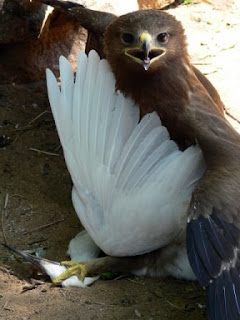“Ally come”
“Sit”
“Up”
“Stay”
“Turn”
“Sit”
“Up”
“Stay”
This was pretty much what I was doing with Ally now. The possibility of teaching crocodiles is the biggest inspiration to try out new things and do more. I was so amazed by the fact that they assess their immediate environment so well and figure out a way in which they get the maximum benefit. Survival instincts, I guess. But is this instinctive behavior? In the captive environment, these crocs figured that they have best chances of survival if they “participate” and “perform” and so they do participate and perform. This is very similar to any animals with supposedly higher intelligence, including humans. This basically means that they are thinking and evaluating everything that is going on! Still instinctive behavior? Probably not! Definition of instinct is “an inborn complex behavior of a living organism that is not learned". Well, learning tricks that are completely unexpected and which sometimes include problem-solving skills disproves the age-old impression of crocs being highly instinctive animals.
With Ally, “sit”, “up” and “stay” was looking a bit incomplete. So what would complete this string of commands? Ralf had now gone back to Germany. I was now on my own. I remember him saying “Don’t limit yourself. Crocs are very intelligent. They are smarter than you think they are”.
I saw a greater prospect in working with Ally; simple reason being that she is an American Alligator. They are one of the calmest species; more trustworthy and plus she is so cute! One day I was just imagining how cute she would look if she made (cute) jumps. Hey wait a minute, how about making her jump to complete that string of commands? Awesome idea!
"Ally jump"
It took her 4 days to learn jump and now it is one of the major attractions! Sometimes she misjudges the front-leg – hind-leg coordination and ends up making a really funny cute quarter-jump. I call them Alligator jumps.
Now the crocs were getting ample playtime in the form of enrichment activities but crocodile training is also a major management tool. Dangerous animals like crocs have to go through a lot of stress while being restrained for any concerned reasons like for e.g. Veterinary intervention. To make it smooth, crocs can be trained to enter specially designed wooden crates (boxes) with windows on the sides. These boxes are pretty compact entering which does not allow turning around in any ways. Once the croc goes in, you close the doors and do all the necessary checkups, medication, take samples for lab, etc. with no safety issues and minimal stress on the animal. In species like American Alligators, a lot of this is possible even without the crate! The trick is to desensitize them. Desensitizing is a procedure to take the animal’s physical comfort to such a level that it ignores and tolerates almost all physical contacts to its body. It is the same thing when you ‘calm down’ a freshly caught snake. It all starts by gently touching the body (safest part first) of a croc and slowly getting it used to it. Then gradually you try to cover as much as possible. A desensitized croc is way much easier to manage whenever there is an intervention needed and it is always better to be prepared for any such possibilities. With advanced desensitizing, you can also draw blood samples without physically restraining the croc! To give it a try, I started desensitizing Ally and now she allows me to do almost anything! It is really amazing how it works. I wouldn't have believed it if I hadn't tried it myself.
Desensitized Ally
My next target is to desensitize her to draw a blood sample. It will be so cool to maintain a health report that includes regular blood checks.
END OF PART THREE.
To be continued...














